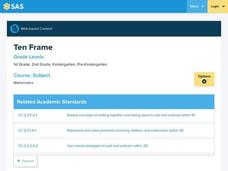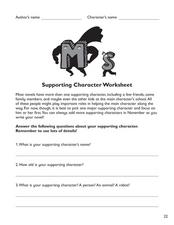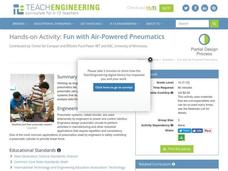Curated OER
The Worldly Philosophers by Robert Louis Heilbroner
CliffsNotes provides a list of study questions to help your high schoolers grapple with The Worldly Philosophers. Some of them are simple and straight forward, while others offer an opportunity to dig in deeper! Consider printing this...
Curated OER
Verbally Speaking
Verbs are the center of attention in this resource. Students discover that a verb shows action, then they consider twenty sentences that each have an action verb. Students must click on one of three words at the bottom of each slide in...
Curated OER
Acoustic Poems
Students explore acrostic poems. In this interactive poetry lesson, students visit the ReadWriteThink.org website to view characteristics and samples of acrostic poems. Students develop acrostic poems by using the interactive site.
Curated OER
Animated Alphabet
Students explore English by completing an interactive language history activity. In this word recognition lesson, students discuss word formations and the phonetic relationship between letters. Students identify the origin of individual...
Curated OER
Learn-to-Read Pumpkin Patch
Learners practice identifying and pronouncing the short letter "u" sound. For this phonetic awareness lesson, students access the Starfall.com website and follow the directions on the screen to reinforce the short "u" sound. Learners can...
Curated OER
Left-to-Right Reading
Left-to-right, left-to-right, that's the way we read and write! Watch this short video clip and teach your young learners this chant before they start writing!
Curated OER
Further Investigating Greater Than, Less Than, and Equal to
Students investigate number relationships such as greater than, less than, and equal to. In this number relationship lesson, students use number mats and a fish with a large, open mouth to practice showing number relationships.
Curated OER
Ten Frame
Students add numbers to ten. In this addition to ten lesson, students play the Ten frame interactive game to learn about addition and facts to number ten.
Curated OER
Patch Tool
Students use an Internet tool to explore shapes and how they combine. In this patterns lesson, students create quilting patterns using various shapes. Students recognize how the shapes fit together.
Curated OER
Rules of Thumb for Diction
What is the difference between accept and except? Affect and effect? Brilliantly advise your class with the advice in these slides. Definitions of commonly misused words from A-Z help clarify meaning and usage.
K12 Reader
Reflexive Pronouns
I, myself, like a straightforward grammar exercise, and here is one about reflexive pronouns! Learners identify the reflexive pronoun in each of 20 sentences and indicate the subject that the pronoun refers to.
Curated OER
Supporting Character Worksheet
Where would Harry Potter be without Ron Weasley? Where would Holmes be without Watson? Where would a good narrative be without an interesting supporting character? Encourage character analysis with this resource, which includes six...
Florida Center for Reading Research
Phonics: Letter-Sound Correspondence, Photo Chart
Have fun with student photographs in this phonics activity! Learners sort their classmates' photos by initial sound on a large poster board with the alphabet written vertically down the left side. Also provided are various pictures...
Florida Center for Reading Research
Phonological Awareness: Onset and Rime, Guessing Game
An activity challenges scholars to show what they know about onset and rime. Learners choose from a stack of picture cards and give onset and rhyming clues to see if their partners can guess the word they are holding.
Florida Center for Reading Research
Sound it-Bag it
Scholars sort picture cards based on the initial phoneme they hear as they say the name of each image. They pick a card, say its name, then place it in one of five bags based on how its initial phoneme matches the initial phoneme...
Curated OER
The DIY: A Hands-On Look at the New Industrial Revolution
Upper graders explore the new industrial revolution and how the tech boom in recent years is similar and different to the Industrial Revolution of the past. They watch a video, explore web sites, and discuss what they see. They work...
Teach Engineering
Fun with Air-Powered Pneumatics
How high did the ball go? Engineering teams build a working pneumatic system that launches a ball into the air. The teams vary the amount of pressure and determine the accompanying height of the ball. An extension of building a device to...
NASA
Space Images
As technology advances, so does our understanding of the universe around us. Thanks to the Hubble Telescope, Mars rovers, and other high-resolution cameras, there are amazing photographs of celestial bodies, planets, comets, and more...
Two Lives Left
Cargo-Bot
What would you think of an app that provides a creative introduction to an important 21st century skill, challenges learners at many levels, and is an addictively, fun game? Did we also mention it was free? We think you will find all...
TCI
What Are the Biggest April Fools Jokes of All Time?
After working in groups to analyze primary sources related to a historical hoax, learners will discuss how people managed to be fooled and work to identify one of the biggest April Fools jokes in history.
Lakeshore Learning
Alphabet Sounds Teaching Tubs
A hands-on activity brings the alphabet to life in your kindergarten! Fill tubs with items that begin with the same letter or end with the same sound, and let kids make the connections between the items.
Drama Teacher
The 12 Dramatic Elements
Plays are meant to be seen and so are these 12 elements that give plays the dramatic effect. Introduce young actors to these key terms and their explanations
Spur Design
PrestoBingo Colors
Open children's eyes to the wonderful world of colors with a fun interactive game. From red, blue, and green to garnet, sapphire, and chartreuse, this resource engages young students in learning about all sorts of different colors.
Read Theory
Analogies 2 (Level 8)
Examine nuances in word meanings with an exercise based around word analogies. Learners use the sentences and frames provided to help them determine the relationships between words. They complete 10 analogies.

























